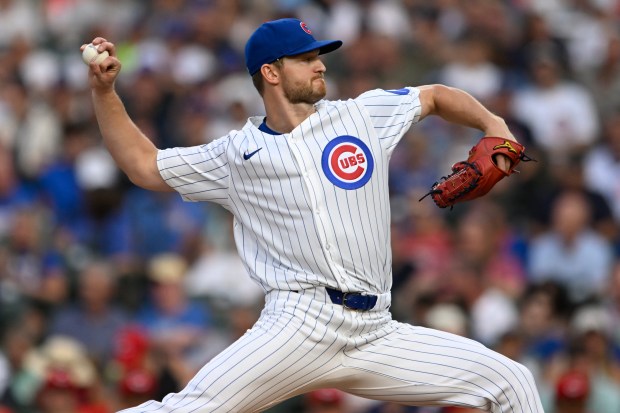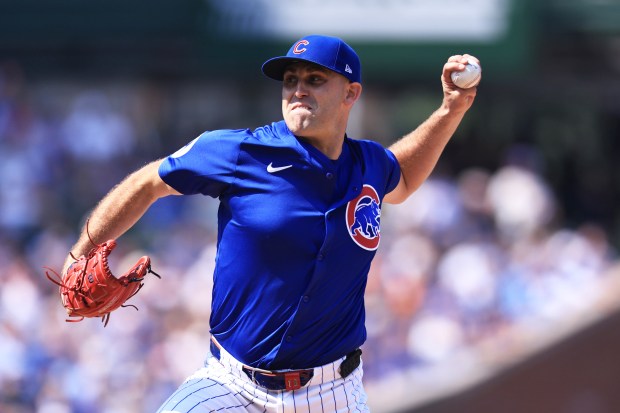Jed Hoyer’s season has basically mirrored the team he runs.
A great start that led to accolades and a contract extension from Chicago Cubs Chairman Tom Ricketts three days before the trade deadline has been followed by a late summer drought that threatens to spoil a dreamlike season.
The Cubs now trail the Milwaukee Brewers by four games after leading them by 6½ on June 18. Hoyer’s lost gamble on Michael Soroka’s health at the trade deadline puts the rotation in another bind.
So the damage is done.
But there’s still time for the Cubs to get back on course, starting Friday in St. Louis, where they open a six-game trip against the Cardinals and red-hot Toronto Blue Jays.
Whether Hoyer will recover from the Soroka mess might depend on whether the Cubs make the postseason. They began Thursday with a 97.2% chance, according to FanGraphs, though their odds of taking the division had plummeted to 32.5%.
Cubs fans are understandably upset with Hoyer, who made a lot of noise about acquiring a starting pitcher for the stretch run and then settled on the Washington Nationals’ Soroka, citing a “tight market” and unreasonable asking prices for frontline starters. The Cubs kept their top prospects, which seemed to be Hoyer’s most important goal, even at the risk of a better shot at postseason success.
As Hoyer explained his decision-making to the media at the team’s office building next to Wrigley Field, a siren blared from the Waveland Avenue firehouse, increasing in volume as he spoke. You can’t make this stuff up.
Whether Hoyer heard the alarm bells is unknown. Soroka’s injury history, however, was well-known, and his recent numbers with the Nationals weren’t impressive: an 0-5 record with a 4.87 ERA over his last nine starts. But he had 52 strikeouts in 44 1/3 innings in that span, and the Cubs needed a swing-and-miss guy out of the bullpen, which was probably where Soroka was headed once Jameson Taillon returned.
Hoyer had tried to sign Soroka in the offseason, despite an 0-10 record and 4.74 ERA with the 2024 White Sox. But the Nationals surprised almost everyone with a one-year, $9 million offer that was too pricey for Hoyer. He smartly changed course and wound up signing the more affordable Colin Rea a month later for a guaranteed $5 million with a $6 million option for 2026.
Though Rea competed for a starting job in spring training, he lost out to Ben Brown and wound up in the bullpen until Justin Steele’s season-ending elbow injury in April forced him back into the rotation.
 Cubs starter Michael Soroka pitches during the first inning against the Reds on Monday, Aug. 4, 2025, at Wrigley Field. (AP Photo/Paul Beaty)
Cubs starter Michael Soroka pitches during the first inning against the Reds on Monday, Aug. 4, 2025, at Wrigley Field. (AP Photo/Paul Beaty)
Soroka’s velocity was trending down with the Nationals, from a 94.9 mph fastball average on June 22 to a 90.9 average on July 23. He underwent an MRI “for my peace of mind” before his last start with the Nationals, and the Cubs were aware of the test results.
When he reported to work at Wrigley, Soroka told the media Sunday the drop in velocity was not a big concern.
“Going through stuff, things we worked through (in Washington),” he said. “We talked to the Cubs when that happened and they were aware. I think that’s something we can move through pretty quickly and get going with.
“Obviously we deal with struggles, whether it be physical or mechanical or whatever it is. Got to keep competing. I’ve found I can compete with a couple less miles an hour, though it’s nice to have 96-97 in the back pocket. We can make it work for now. I have confidence it will be back before long.”
But Soroka’s four-seam fastball never got above 91 mph in a 31-pitch debut against the Cincinnati Reds on Monday, and he was removed after two innings and placed on the 15-day injured list with a right shoulder strain.
Cubs fans were apoplectic. From appearances, it looked as though the Cubs received damaged goods. But Hoyer knew the risk and admitted as much when he spoke to the media Tuesday, saying, “Right now, it’s not looking like a good bet.”
Executives take gambles on players with injury histories all the time, and manager Craig Counsell pointed out Hoyer also took one on Matthew Boyd, who turned into an All-Star and one of the game’s top starters this year.
 Cubs starter Matthew Boyd pitches during the sixth inning against the Orioles on Saturday, Aug. 2, 2025, at Wrigley Field. (Geoff Stellfox/Getty Images)
Cubs starter Matthew Boyd pitches during the sixth inning against the Orioles on Saturday, Aug. 2, 2025, at Wrigley Field. (Geoff Stellfox/Getty Images)
But Boyd had been effective after returning last August with the Cleveland Guardians, who gambled on him by signing him in June 2024 while he rehabbed from a year off after Tommy John surgery. Soroka, meanwhile, was average at best this season for the Nationals, even without the velocity question.
The timing of the injury could not have been worse, with the Cubs losing ground in the division to the Brewers and Hoyer having just agreed to an extension.
The move was reminiscent of a six-player offseason deal between the White Sox and Blue Jays in January 2001 that sent starter David Wells and reliever Matt DeWitt to Chicago in return for starter Mike Sirotka and three other players.
Sirotka passed a physical, but a second exam revealed a possible torn labrum. The Blue Jays asked the league for compensation when Sirotka was deemed damaged goods with the labrum and rotator cuff injuries in a controversy dubbed “Shouldergate.”
“My first thought is that I was hurt when they traded me,” Sirotka said after the deal. “I don’t know if you can blame both sides for either not being truthful or not knowing how serious it was. But the bottom line is, I was hurt before the trade.”
But Commissioner Bud Selig upheld the transaction with a 14-page ruling that blamed the Blue Jays for not doing their due diligence. He wrote: “The ‘caveat emptor’ rule, as developed in baseball, to which exceptions are exceedingly rare, is meant to decrease the potential for disputes by placing the burden on the acquiring club to seek the media information it feels it needs.”
Sirotka never pitched in the majors again, and it was just a small chapter in the career of former Sox general manager Ken Williams.
Hopefully Soroka’s injury isn’t serious enough to merit a “Shouldergate II” and he’ll return to the Cubs after resting the shoulder a few weeks. But if he isn’t able to pitch — or struggles when he returns — it would be Hoyer’s burden to bear.
A prime chance to upgrade the rotation would be considered wasted, and it would be up to Taillon, Brown or Javier Assad to give the Cubs a dependable fourth starter for October to go with Boyd, Shota Imanaga and Cade Horton.
That’s assuming the Cubs get there, which depends on their streaky offense returning to form. Amazingly, they still ranked second behind the Los Angeles Dodgers in runs scored through Wednesday, despite being tied for 22nd since the All-Star break. That shows how dominant they were for a 3½-month stretch, and it’s why Hoyer and Counsell are optimistic they’ll rebound.
But it’s not just one or two players. Kyle Tucker, Pete Crow-Armstrong, Michael Busch, Seiya Suzuki, Dansby Swanson, Ian Happ and Carson Kelly all need to pick up the pace, or else the rotation conundrum won’t matter.
Is it time for fans to start focusing on the wild-card race and concede the National League Central to the Brewers?
Not at all. A five-game showdown Aug. 18-21 at Wrigley looms, and if the Cubs can narrow the gap or take the lead after that series, there’s no reason to think they can’t win the division and even earn a bye with one of the league’s top two records.
They’re treading water, not collapsing, but with the Brewers streaking, all bets are off.
The Cubs’ swing-and-miss on landing a top starter at the trade deadline — and then getting an injured one — has tempered expectations from many fans. Most figured Hoyer would go for it with Tucker’s future uncertain and a team that looked certain to make some noise in October.
The contract extension coincided with a more conservative approach by Hoyer.
Only he knows if he would’ve swung a bigger deal had his own future been on the line.
